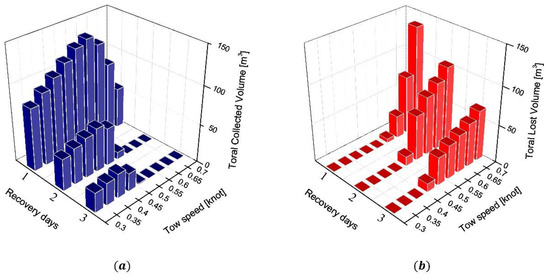Abstract
Ability to estimate the recovery potential of countermeasures is vital in establishing a rational response solution for oil spills at sea. This requires estimation of how much oil can be recovered and the determination of the rational quantities and operating conditions of the response equipment. In this study, a constant loss rate model and a variable loss rate model were developed to estimate the recovery potential of a mechanical oil recovery system, while considering the escape of oil containment booms. The latter model could calculate the speed at which oil loss began to occur and the volume of oil lost. A case study was performed to analyze the significance of oil loss and to calculate changes in recovery potential with respect to adjustable vital variables. The developed model was able to estimate the best operating situation, which optimizes the recovery potential for different response times and environmental conditions.
1. Introduction
The oil spill disaster has an impact on the marine environment and ecosystem [1,2]. For both large and small oil spills, it is essential to establish an effective response strategy for the cleanup operation by ensuring that the oil is quickly recovered from the contaminated area. Various response technologies have been developed to recover oil, with the most common option being mechanical recovery using a skimmer and oil boom. This mechanical recovery does not cause any secondary pollution and minimizes environmental damage from pollution accidents when compared to other response methods [3].
The objective of the response strategy is not only to maximize the recovery of the spilled oil but also to minimize the number of skimmers that need to be mobilized, i.e., to ensure that the response is proportional to the scale of the spill. Response contingency planning should also focus on the appropriateness of the mechanical cleanup and the response capability of mechanical recovery for the countermeasure [4,5].
In order to rationally respond to oil spill accidents, it is crucial to be able to estimate the recovery potential of the response equipment, considering the characteristics of both the oil and the marine environmental conditions. To estimate the recovery potential, it is necessary to be able to predict changes in the performance of the response equipment for oil cleanup by considering various factors that can change in actual accidents, such as spreading, weathering processes, and recovery equipment specifications [6,7]. In order to maximize the mechanical recovery, observation or monitoring should be carried out [8,9,10]. Remote sensing can be employed to determine the extent of the spill and guide the response activities.
After the oil is spilled offshore, it quickly undergoes spreading and weathering processes, including evaporation, dispersion, and emulsification [11,12,13]. The properties of the oil are strongly influenced by the weathering process, which is governed by environmental conditions. For example, as the weathering process progresses, the evaporation changes the composition of the spilled oil, and the emulsification alters the water fraction of the emulsion. As a consequence, the viscosity increment due to evaporation and emulsification causes degradation of mechanical recovery efficiency. Therefore, the spreading and weathering process should be considered in evaluating recovery performance. Spaulding [12,13] reviewed and analyzed oil transport and fate models, including spreading, evaporation, dissolution, entrainment, emulsification, biodegradation, and sedimentation. Among them, several spreading and weathering models were used in this study to simulate the oil behavior on the sea surface.
The purpose of recovery potential estimation is not to predict the exact recovery volume in the given environmental conditions, but to ascertain that the oil recovery volume depends on various factors and to reflect these factors when establishing response strategies [14]. To make a reasonable decision based on the response strategy, it is required to evaluate mechanical recovery capacity. Several previous studies have focused on the recovery potential estimation of skimmers [15,16,17,18].
The effective daily recovery capacity (EDRC) is a planning method that estimates the required daily oil recovery capacity for the skimmer to respond to a given spill. The EDRC is calculated by considering the total nameplate capacity of the skimmer, its operating time, and its mobilization efficiency. The performance change due to variations in oil properties and characteristics of the recovery equipment is solely described with the mechanical efficiency, which is considered to be a constant value (0.2) in EDRC. The advantage of EDRC is that it can quickly estimate the capacity of the skimmer required for mobilization because of its relatively simple estimation method. It can also be used to regulate the regional preparedness capacity to ensure adequate response resources in the case of an oil spill [18]. However, EDRC is not suitable to be applied universally to all accidents because it assumes a constant mechanical efficiency.
Other recovery potential estimation models have been developed based on the encounter rate. ASTM F1780-18 provides a calculation procedure for evaluating clean-up equipment [14]. This methodology provides guidelines for estimating recovery effectiveness against the target spill, considering the oil slick’s condition and the recovery system’s parameters, based on the encounter rate. However, its ability to examine changes in the oil slick and clean-up equipment is limited, since the recovery efficiency is assumed to be constant per day, as are the oil slick thickness and the emulsification factor.
Furthermore, the estimated recovery system potential (ERSP) calculator was developed as a planning tool for estimating the mechanical recovery potential of the recovery system, based on the encounter rate [17]. Similarly, the response options calculator (ROC) estimates the recovery potential based on the encounter rate, in combination with calculating the weathering process, oil property changes, and oil thickness [16,19]. These provide additional options for estimating the dispersant application and the burning of oil along with the performance of the mechanical recovery. It is advantageous to consider the recovery efficiency of the skimmer with respect to viscosity and wind speed, based on hourly changes in the oil’s parameters. Although the efficiency of both the boom and the skimmer are important components of the recovery potential estimation, the ROC assumes boom efficiency to be constant values.
The encounter rate-based recovery potential estimation models, including ASTM F1780-18 [14] and ROC [16,19], are strongly correlated with the speed at which the oil slick is collected into the oil boom. In other words, the potential capacity of the recovery system increases with the speed at which the oil slick is collected. However, when the tow speed is increased above a certain speed, the collected oil may be lost as it bypasses the oil boom, which decreases not only the performance of the oil boom [12,20] but also the recovery capacity.
A boom’s ability to contain the oil is affected by environmental conditions such as currents, wave, and wind, and on oil properties such as density and viscosity. These dynamic forces may lead to boom failure and loss of oil. Equipment specifications, such as the freeboard and draft of the oil boom, can also influence oil loss [20]. There are several modes of boom failure, including entrainment, drainage, splash over, submergence, and planning [11,21]. These types of failure can be analyzed with the speed of water current, skimming velocity, wave height, and design of the boom. These are one of the most critical factors in estimating the recovery potential, but few studies have taken the loss of oil from the boom into account.
In this study, two models were developed to estimate the recovery potential while considering the loss of oil from the boom, in an effort to propose how oil loss should be reflected in models based on the encounter rate. One model featured a constant loss rate model, while the other had a variable loss rate. The speed at which the oil loss begins to occur and the volume of oil lost were quantified by an empirical correlation and experimental data. The calculation procedure of the proposed models was designed to indicate the collection performance of the boom. A case study was carried out to calculate how the recovery potential varied with adjustable key variables and to emphasize the difference between the two models. This allowed the analysis of how the adjustment of tow speed and size of the boom in the models affected their recovery potential.
2. Methods
2.1. Recovery Potential Estimation Model Based on the Encounter Rate
Figure 1 shows a schematic of a typical mechanical recovery system used to recover oil spills at sea. The recovery system includes an oil boom for capturing the oil, a skimmer for recovering the oil, and a vessel for providing advancing velocity [14]. The effectiveness of the recovery system is a measure of how much oil can be recovered from the sea surface through the given set of resources during an allocated operating time [14]. The overall performance of the recovery system depends on the performance of each component, such as the oil boom and the skimmer.
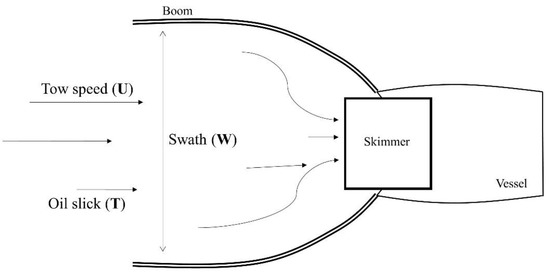
Figure 1.
Schematic of the mechanical recovery system.
Previous recovery potential estimation models [16,17] have been developed using the encounter rate (EnR), defined as the recoverable oil volume per unit time by the recovery system.
where W is the boom swath, U is the tow speed, and T is the oil thickness.
The encountered oil volume can be regarded as the maximum recoverable oil volume per hour. In other words, the effectiveness of the recovery system is governed by the volume of encountered oil collected in the boom and the volume of water that passes through the skimmer. The oil slick thickness changes over time, by the spreading and weathering of oil [22,23,24,25]. The performances of the boom and the skimmer are both affected by the environmental and operating conditions, and by the equipment specifications. To represent recovered oil, the oil and emulsion recovery rate (ERR) is determined from the performance of the oil boom and the skimmer. ERR is defined as follows.
where ERR is the oil and emulsion recovery rate, EnR is the oil encounter rate for the boom, TE is the throughput efficiency, TFRR is the total fluid recovery rate, and RE is the recovery efficiency of the skimmer. TE is defined as follows [17].
The performance of the boom can be quantified using TE, which represents the ratio of the oil and emulsion volume recovered through the skimmer to the oil and emulsion volume encountered by the oil boom [26]. TE is evaluated for the advancing recovery system based on its tow speed [12]. This corresponds to the effectiveness of the boom, which is the containment component in the recovery system. TE can, therefore, account for the loss of oil in the encountered oil [17]. A high TE implies that most of the encountered oil is being recovered by the recovery system. In the calculation processes of previous studies [14,16,17,19], RE (Equation (2)) has been defined as a ratio of how much water is retained, and has been used to determine the amount of water.
Though TE is a crucial factor in estimating the recovery potential, the models of a previous study [16] and the constant loss rate model in this study is assigned a constant value (usually 0.75). In addition, the previous study used a constant TE regardless of the type of oil and the severity of the marine environment. Therefore, there is a need for more studies that consider the variation of TE, according to accidental and environmental conditions.
To overcome this limitation, a modified definition for TE was adopted in the variable loss rate model of this study. This new model accounts for oil loss, i.e., the performance of the boom, as shown in Equation (4).
Though the constant loss rate model used a constant TE value, the variable loss rate model was able to simulate variations in TE through time. The revised TE in Equation (4) can be calculated by considering both the oil loss speed and oil loss volume. In this study, ERR was regarded as a concept of collecting performance rather than recovery performance. Oil loss occurs once the tow speed exceeds oil loss speed. When the tow speed is lower than the oil loss speed, the TE is 1, since there is no loss. In this case, the recovery system can recover all of the encountered oil. If the tow speed exceeds the oil loss speed, TE returns values between 0 and 1, depending on the loss rate.
Figure 2 shows an outline of the revised recovery potential estimation model (herein, the ‘variable loss rate model’). The variable loss rate model consists of three parts: the oil spill accident input, calculation of the oil’s behavior, and calculation of the recovery capacity. The oil spill accident input involves setting the input values for the environmental conditions, oil information, and initial spill volume. The weathering and oil thickness changes are then calculated, accompanied by the physical and chemical behavior of the oil.
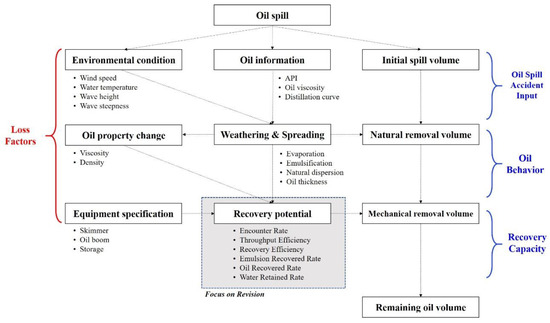
Figure 2.
Schematic of the developed model for estimating the recovery potential (variable loss rate model).
As described in the previous section, the spreading and weathering processes significantly change the oil properties, and then affects the efficiency of the recovery system. The two models of the present study were developed based on the spreading and weathering models of the previous study [19]. Fay’s model [23,27] was used to calculate the spreading of the oil. The area was expressed as a function of the initial spill volume, density, and viscosity of the spilled oil and time. To estimate the oil evaporation, the Mackay and Matsugu model [28] was used. The evaporation rate was influenced by factors such as wind speed, oil area, and water temperature. The dispersion was calculated using Delvigne and Sweeney [29]. Natural dispersion was dependent on both the oil properties and the amount of sea energy [12]. In addition, the water fraction change of the emulsion was considered with Eley et al. [30].
The equipment specifications, oil behavior, and environmental conditions are critical factors in estimating the recovery potential. The boom specifications (i.e., type, draft, B/W ratio, and swath) and the skimmer specifications (i.e., type, nameplate capacity, and skimming speed) were considered. The oil behavior, such as spreading and weathering processes, was calculated every hour. Furthermore, the environmental conditions, including wind speed and waves, were considered. The currents could be considered using the relationship between the current velocity and the tow velocity of the skimmer. The recovery system removes the oil mechanically from the sea surface. Therefore, the remaining oil volume can be estimated by considering both mechanical recovery by skimmers and natural removal processes by evaporation and dispersion. In this calculation process, the focus was given toward improving the recovery potential. The loss factors of Figure 2 were regarded to be factors representing the equipment specifications, oil behavior, and environmental conditions.
The detailed procedure for calculating ERR, using the developed correlations for the loss speed and the loss rate, is illustrated in Figure 3. EnR can be calculated for a tow speed of the skimmer, UTow. Furthermore, the first loss speed, U1st, and the critical loss speed, UCrit of the boom, can be calculated using the developed correlations in terms of wave steepness, oil density, draft, and B/W of the boom. ERR can be estimated by calculating TE based on the loss speeds and the loss amount per unit time.

Figure 3.
Calculation procedure for quantifying boom loss.
ASTM standard guide F2084 [31] provides the test method to determine the effectiveness of oil spill containment booms with towing and wave conditions. The first/gross loss speed and the critical loss speed can be used to evaluate the effectiveness of the boom based on the standard guide. Therefore, U1st and UCrit can be the criteria for determining the occurrence of oil loss. If UTow exceeds UCrit. The oil boom cannot capture the oil. This is defined as the ‘no capture mode.’ In this condition, TE is zero regardless of the loss rate because the captured oil is wholly lost. If UTow is lower than U1st, then none of the encountered oil is lost, which is termed the ‘no loss mode.’ The ‘loss mode’ refers to instances where UTow lies between U1st and UCrit. Depending on the loss rate, TE varies from 0 to 1, which is expressed in Equation (4). The obtained TE is then an estimate of how much of the captured oil is lost.
This calculation process of TE and ERR is performed every hour. By accumulating the calculated ERR, the total volume of the oil collected is obtained, which helps determine the total recovery potential capacity.
2.2. Quantification of Oil Boom Loss
As described in Section 2.1, the occurrence of oil loss from the boom can be calculated using the loss speed. According to ASTM F2084 [31], the first loss speed (U1st) is defined as the lowest speed at which the oil starts to escape, during which oil droplets are continuously lost as they pass below the bottom of the boom [31]. If the oil boom is towed at a high speed, or moored in a fast current, turbulence is generated around the captured oil. At this time, droplets of the captured oil can become separated and lost. As defined by ASTM F2084 [31], gross loss speed (UGross) is defined as the speed at which massive oil, rather than droplets, is continuously lost. Once the tow speed (UTow) exceeds U1st, the oil loss volume increases in proportion to the difference between U1st and UTow. The critical loss speed (UCrit) is the speed at which the oil cannot be captured due to high waves or fast currents such as splash-over, submergence, or planning [31]. UCrit is dependent on the buoyancy, roll response, and heave response of the boom [32]. In this study, the loss rate of oil was quantified using the difference between U1st and UTow. ASTM standard F2683 [33] provides the guidelines for selecting the boom for the oil spill response, according to wave conditions categorized by ASTM standard F625 [34]. Therefore, the oil boom loss was correlated with wave steepness in this study.
TE, as defined in Equation (4), correlated with the encountered and lost volumes of oil of the boom. An empirical correlation of U1st, UCrit, and loss rate was modified to quantify TE in terms of loss speed and loss rate. In this study, U1st was defined as the minimum speed at which the oil loss is initiated in the encountered oil, and UCrit was defined as the maximum speed at which the oil is wholly lost. The loss rate determines the TE of UTow that operates between U1st and UCrit. In this study, the unit of loss speed was expressed in m/s. The tow speed was expressed in knots (m/s), taking into account the conventional operating speed unit.
2.2.1. First Loss Speed
The entrainment failure of the oil boom can occur at relatively low speeds when compared to other modes of oil loss. It is one of the most sensitive phenomena that can limit the containment capability of the boom [20,35,36,37]. Wicks [38] conducted a study on the three different oil loss regions (head wave, intermediate, and near-boom), and observed that oil droplets are separated from the head wave by high water velocities. It was found that this phenomenon was affected by the Weber number (We), which is expressed as the balance of the inertia force and surface shear. Agrawal and Hale [39] found, through an experimental study, that the critical We value at which entrainment occurs in the head wave region is 28.2, which is twice the value presented by Wicks [38]. Concerning the effect of the Kelvin-Helmholtz wave, which is formed by instability at the oil-water interface, several studies have observed the formation of oil droplets by breaking waves [40,41]. Leibovich [40] expressed the region at which entrainment occurs, as displayed in Equation (5).
where UKH is the Kelvin-Helmholtz threshold instability velocity [cm/s], is the water density [g/cm3], is the oil density [g/cm3], g is gravitational acceleration [cm/s2], and σ is the oil-water surface tension [mN/m].
Lee and Kang [42] proposed an empirical equation related to the threshold speed at which oil entrainment occurs, based on UKH and the oil density. Amini and Schleiss [43] modified the coefficient of the empirical equation presented by Lee and Kang [42] by considering the initial failure velocity in the presence of wave steepness, as shown in Equation (6).
where U1st is the first loss speed [cm/s], D is the oil boom draft [cm], ∆ is the oil density relative with the water [-], and s is the wave steepness [-].
The effects of wave steepness on the first loss speed were experimentally tested by Ohmsett and the Canadian Coast Guard [21]. The majority of the data were classified according to their wave steepness, at values of 0, 0.021, and 0.065, as shown in Figure 4. This wave steepness (s) represents the ratio of wave height and wave length.
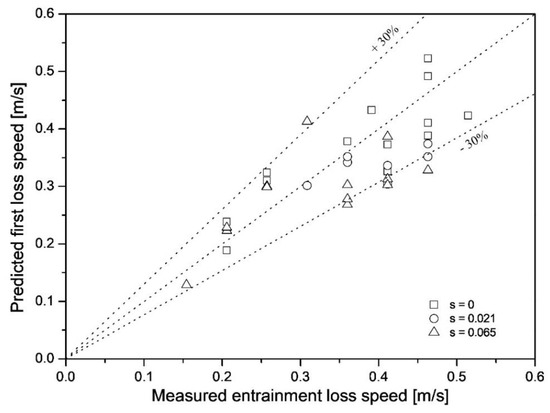
Figure 4.
Comparison of predicted first loss speed to measured entrainment loss speed, based on Equation (6) and the measured entrainment loss speed of Schulze [21].
2.2.2. Critical Loss Speed
UCrit is the loss speed at which the oil can no longer be collected usually because of the instability of the boom. The previous study [44] has evaluated the effect of waves and the B/W ratio on the performance of the oil boom. The B/W is the ratio of the buoyancy and weight of the boom. Schulze [21] summarized experimental data on the planning, submergence, and splash-over loss speed of the boom. In this present study, the critical loss speed was correlated as a function of the wave steepness and the B/W ratio in order to quantify it, as shown in Figure 5. UCrit approaches U1st in poor conditions with high wave steepness, which indicates that critical losses can occur immediately. The decrease in UCrit is noticeable at B/W ratios of <10. In this study, the ratio of UCrit to U1st is correlated as a function of the boom specification and the environmental condition based on the test data [21], as shown in Equation (7).
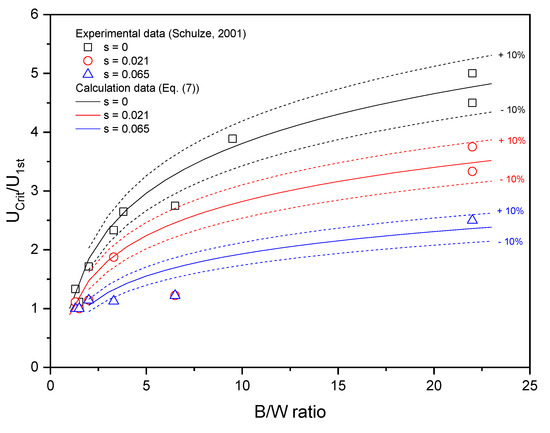
Figure 5.
Critical loss speed according to the B/W ratio and wave steepness.
2.2.3. Loss Rate
In order to quantify the performance of the oil boom, it is crucial to know not only when oil loss occurs, but also the volume of oil being lost. The former is related to the loss speed, and the latter is related to the loss rate. The loss rate of the oil captured in the boom increases proportionally to the difference between the tow speed and the loss speed. The majority of previous studies that have estimated the loss rate used empirical forms obtained by the correlation between laboratory data and field data [39,45,46,47]. The empirical loss rate equation of Lindenmuth et al. [47] and Agrawal and Hale [39] was described in terms of dimensionless numbers. The study of Fannelop [46] was carried out just for one type of test oil. Therefore, it is not sufficient to estimate the loss rates of various oil types. Amini et al. [45] proposed a loss rate model, according to the draft of the oil boom, the volume of the captured oil, and the oil loss speed at a low viscosity.
Schulze [21] summarized test data on the oil boom loss rate. These experimental data exhibited loss rates in excess of 0.1 knots (0.051 m/s) and 0.3 knots (0.154 m/s) at the first loss speed. Among the variables of the experimental conditions, the oil boom draft and the preload oil volume, which represents the volume of oil captured by the oil boom in the test tank, were the key factors influencing the oil loss rate. The loss rate data from Schulze [21] and the loss rate model presented by Amini et al. [45] are shown in Figure 6. These results show that the loss rate can be correlated with the draft and preload oil volume regardless of the oil boom type. Furthermore, it can be seen that the loss rate is proportional to the preload oil volume and IU, which describes the difference between U1st and UTow, while the draft is inversely proportional to the loss rate.

Figure 6.
Loss rate per preload volume (qloss/V2/3) according to the draft of the oil boom and the difference between the tow speed and the first loss speed.
The loss rate model of Amini et al. [45] is only applicable for low-draft booms because the prototype boom in their experiment had drafts of 0.1 and 0.2 m. Therefore, as shown in Figure 4, their loss rate converges toward zero for drafts larger than 0.4 m. In contrast, the draft in the test data reported by Schulze [21] was larger than 0.4 m, which corresponds to the draft size of most practical oil booms. The data of Schulze [21] is, therefore, not directly compatible with the empirical equation proposed by Amini et al. [45].
Despite the insufficient amount of test data, it is worthwhile to suggest an empirical correlation for the performance of an oil boom. In this study, the loss rate was, therefore, correlated to an exponential function of IU. Furthermore, a correlation between the preload volume and the draft was proposed based on the test data of Schulze [21]. In this study, the empirical correlation is expressed as shown in Equation (8). This is only applicable for booms with a draft higher than 0.4 m. In calculating the recovery potential, the preload oil volume (V) in Equation (8) is regarded as the volume of oil encountered per unit time (EnR). The loss rate is then reflected by TE, which represents the oil boom efficiency of the recovery system. The proposed correlation showed high uncertainty in low IU, as shown in Figure 6.
where qloss is the oil loss rate in m3/h and V is the preload oil volume in m3/h.
3. Results of the Case Study
3.1. Spill Scenario of the Case Study Calculation
A case study was carried out using the developed variable loss rate-based recovery potential estimation model. The accident scenario was made by considering the national contingency response plan of Korea. The purpose of the case study was to find out a relevant adjustable range for the variables that can influence the recovery potential. The calculation conditions of the spill scenario are summarized in Table 1. It was assumed that the oil spill occurred at 07:00 in Busan, Republic of Korea, and that the mechanical clean-up had a duration of three days. The initial spill volume, which consisted of Iranian heavy crude oil, was 500 m3. The weathering and spreading of the spilled oil were calculated every hour. The recovery system started to operate 2 hours after the oil spill occurred, and the clean-up was performed for 33 hours in total out of the three days, since it can be performed during daylight hours only. To calculate the recovery potential, the equipment of the recovery system, including the skimmer and oil boom, was chosen from the World Catalog of the Oil Spill Response Products [48]. The operating conditions were based on the specifications of the equipment and the general tow speed [37]. Since this study mainly considers the loss of oil from the boom, the offloading time and decanting of storage were not considered.

Table 1.
Spill scenario of case study calculation conditions.
The case study featured three cases with different wave steepness values and wind speeds: regular, calm, and harbor chop. The calm and harbor chop environmental conditions were selected from data taken from the ocean observatory buoy of Port of Busan, hosted by the Korea Hydrographic and Oceanographic Agency (KHOA) [49], as shown in Table 2. The variations in wave steepness and wind speed are shown in Figure 7 and Figure 8, in association with the nonadjustable variables. Therefore, a total of nine cases considering three environmental conditions and three boom specifications were calculated to analyze the collecting potential using the variable loss rate-based recovery potential estimation model developed in this study.

Table 2.
Environmental conditions with different wind speeds and wave steepness values.
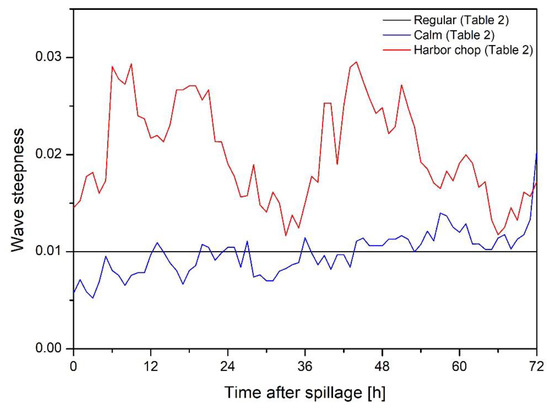
Figure 7.
Wave steepness variation of three environmental cases with time.
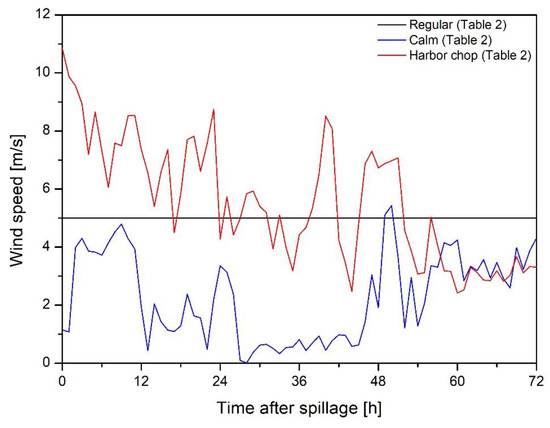
Figure 8.
Wind speed variation of three environmental cases with time.
3.2. Results for Tow Speed Adjustment
Figure 9 shows the calculated U1st over time for three environmental cases in Table 2. All three cases were calculated under the same equipment conditions (boom B in Table 1). Even though the type of oil and specification of the boom were both constant, U1st differed with time. This means that the density changes differed due to weathering and variations in wave steepness. While U1st oscillated over time in the case of calm conditions and harbor chop, during the regular case, it showed a monotonic decrease. This was accompanied with increasing density. The calculated results of U1st on the first day show that the high tow speed recovery operation can be applied without any loss of oil.
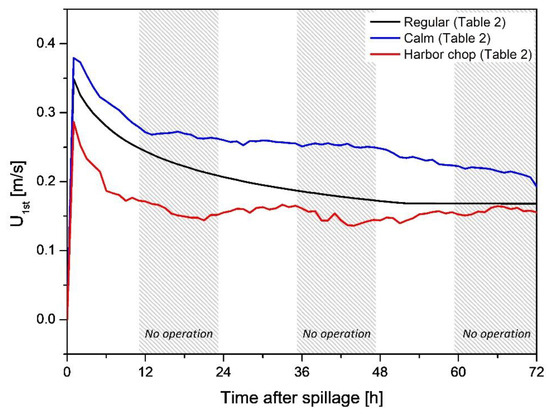
The encounter rate and loss rate, which reflect the difference between UTow (0.5 knots, constant) and U1st are shown in Figure 10. During the initial response time, each case had a high encounter rate because the spreading of the oil slick was limited. For the harbor chop case, in particular, the emulsion percentage was high due to weathering from the high wind speeds. Emulsion makes the oil slick thicker, which results in a higher encounter rate than the regular and calm cases. However, oil loss began to occur from the first day for the harbor chop case, unlike the calm case, and it eventually became equal to the encounter rate. This indicates how much oil is influenced by the UTow and can be used to determine how to adjust UTow in response to different environmental conditions.
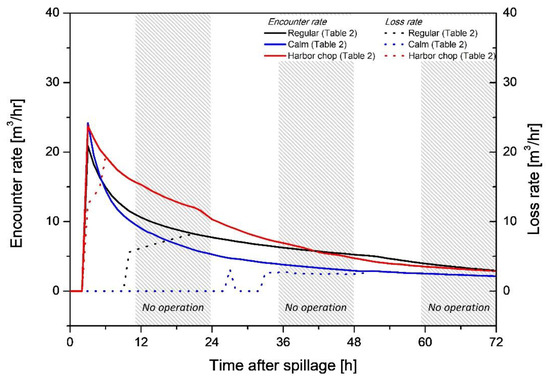
The TE in Figure 11 is a comprehensive value that includes a prior result of U1st, the encounter rate, and the loss rate. Additionally, TE indicated when the loss of oil began and indicated how much oil escaped from the encountered oil. The TE was ~0.5 early in the harbor chop case, before rapidly decreasing to zero. This implies that there were only a few hours on the first day where operation at 0.5 knots (0.257 m/s) tow speed was feasible. In the calm case, TE remained at one until the beginning of the second day but then suddenly decreased, which was related to the loss rate at that time. However, on the third day, the volume of oil encountered was much less than on the first and second days for all of the cases. These smaller encounter volumes mean that the volume of recoverable oil was also small. Therefore, from the quantitative perspective of recovery potential, care should be taken when interpreting the influence of TE over time.
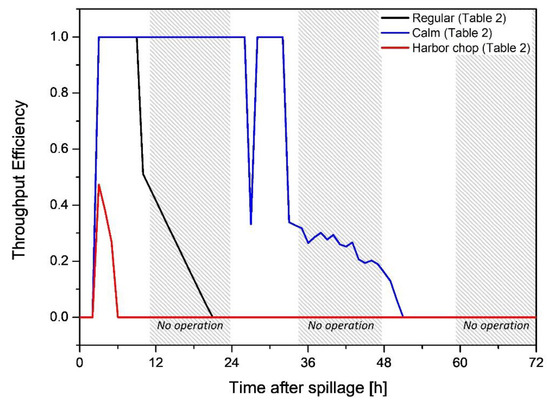
From these results, it is feasible to recover the oil with minimum loss by maintaining the tow speed below or equal to the first loss speed. Figure 12 shows results for tow speed adjustment in which the proposed tow speed in Figure 12 corresponds to the first loss speed.
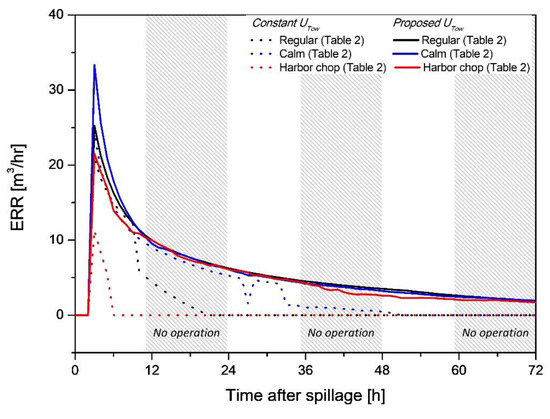
As shown in Figure 12, the ERR for a constant tow speed (0.5 knots, 0.257 m/s) and the proposed controlled tow speed, UTow, correspond to the calculated U1st values. In other words, ERR varied when the recovery system was being towed at the first critical speed. ERR was proportional to TE for constant UTow. The model estimated that ERR decreased continuously over time. For the case of the proposed controlled UTow, towing the mechanical recovery system can be applied by considering the maximum speed without oil loss, and TE was kept as 1. The ERR in the proposed UTow case was expected to be at its highest in the calm case during the first day. However, there was almost no difference in ERR across all of the cases during the second to third days because the oil slick thickness was accompanied by a high EnR, due to the emulsification of the regular and harbor chop case.
A comparison of the total collected volume of oil across the three days between the constant tow speed (0.5 knot) cases and proposed tow speed (U1st) cases is shown in Figure 13. The total collected volume is the cumulative value of the ERR, and it is the collecting potential considering TE. At a constant value of UTow, the value was lower in the harbor chop case because the volume of oil lost was highest during these severe environmental conditions. The difference in total collected volumes between the constant and proposed UTow cases is evident in the harbor chop case.
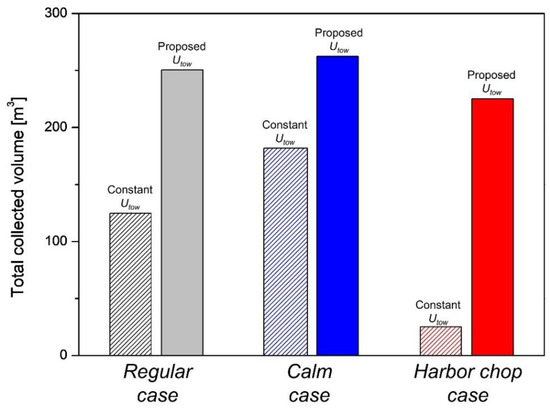
Adjusting the UTow by calculating U1st is meaningful for estimating the recovery potential because the environmental conditions dynamically change with time. While a constant UTow implies the adoption of a uniform operating speed, applying the proposed UTow allows for the adjustment of the operating speed to minimize the occurrence of oil loss. Even in relatively poor marine environmental conditions, it was possible to obtain the best recovery potential for oil collection, providing that U1st was recognized as the maximum speed without oil loss. These results suggest that the developed variable loss rate-based recovery potential estimation model can be used to determine the most appropriate range for UTow. The fact that the potential can be presented as a range rather than a specific value is a significant advantage.
Figure 14 displays the total collected and lost volumes of oil when using boom B during the calm case, with a tow speed of 0.3–0.7 knots. Three conclusions can be drawn from the results of this case study. First, performance was greatest on the first day. Fresh, relatively unweathered oil is critical for the recovery system to operate. Therefore, UTow needed to be controlled to reduce oil loss, especially for the first day. Second, there was a value for UTow that represented the maximum recovery potential within the response time. This was 0.55 knots on the first day, which then decreased by 0.05 knots. This implies that UTow should be determined specifically for each day. Third, a UTow of 0.55 knots led to the best performance estimate on the first day even though there was oil loss during this time frame (Figure 14b). It is suggested that the best performance can be obtained with a fast UTow even though this may result in oil loss.
3.3. Results for Equipment Adjustment
The B/W ratio does not determine the volume of the recovery potential, but is rather an estimate of whether the equipment can be used for the given environmental conditions. For the three boom cases (Table 1), Figure 15 shows variations in UCrit over time for the three different environmental conditions. UCrit was more dynamic than U1st over time, which should provide enough of a margin to utilize the boom. Even in the harbor chop case, the change in the range of UCrit when moving from boom A to boom C was more narrow than in the calm case. This implies that adjusting the boom B/W to avoid critical loss has a limited effect in severe environmental conditions, compared to that in calm conditions. Therefore, before calculating the volume of the recovery potential, countermeasures should be considered to achieve a desirable B/W by estimating UCrit in advance, particularly for poor environmental conditions.
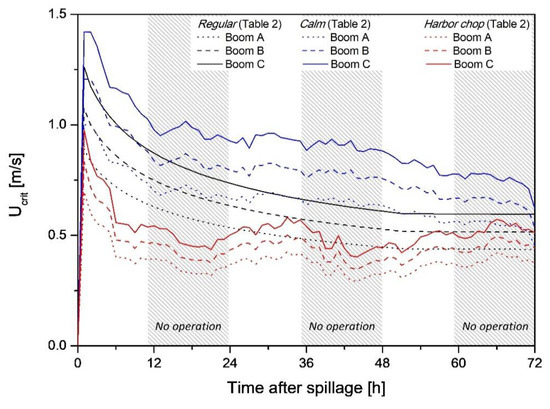
Figure 15.
Critical loss speed with a different boom type at a constant tow speed (0.5 knots) over spilled time: regular, calm, and harbor chop case (Table 2).
The draft is an adjustable factor that can affect the volume of oil loss. Figure 16 describes the fraction of encountered oil being lost at a constant tow speed (0.5 knots) for the three different boom types. The differences in oil loss over time noticeably varied according to the draft size. Boom C showed the slowest oil loss across all environmental conditions due to its higher draft. This enlargement of the boom size eventually hindered the oil loss. However, the larger-sized booms could not wholly prevent oil loss for the harbor chop case. Boom A was rendered useless in this case.
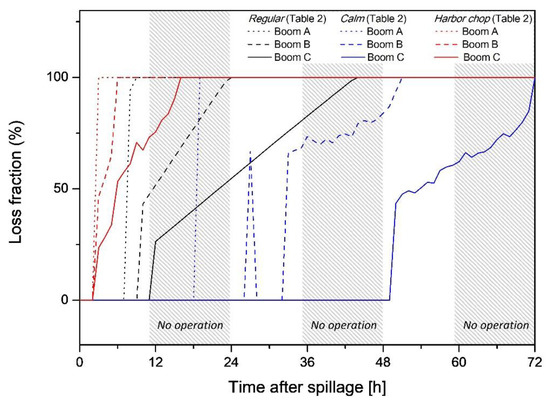
Figure 16.
Loss fraction with a different boom type at a constant tow speed (0.5 knots) over spilled time: regular, calm, and harbor chop case (Table 2).
From the perspective of the clean-up operation, the importance of the boom size appears to significantly depend on the environmental conditions. In calm cases, enlarging the draft size may be important for loss-free operation. In the regular case, it is useful to predict because the loss fraction decreases linearly with the draft size. In the harbor chop case, the size of the boom is only significant during the first day, with respect to preventing the loss of oil. However, the recovery potential on the first day may be very important because enough thick oil slick on the first day makes the recovery effective. It may, therefore, be most useful to adjust the size of the boom on the first day.
Figure 17 shows that, for the harbor chop case, changing the boom had a noticeable result on the first day’s collection volume. While boom A (0.3 m draft) lost all of the oil encountered, enlarging the draft size gradually improved the collection of oil. The collected volumes of booms B and C on the first day are shown in Figure 17.
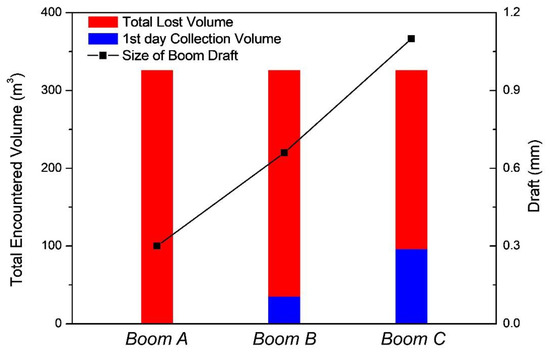
Adjusting both the tow speed and the size of the draft can contribute to a potential improvement of the recovery system. In poor environmental conditions, such as the harbor chop case, UTow can be adjusted to increase the volume of the potential, as shown in Figure 13. However, it is difficult to adjust UTow throughout the whole operating period. Therefore, enlarging the boom size can also be an effective option. In calm environmental conditions, however, it is better to adjust UTow rather than adjusting the size of the draft. The results of this study could be used to suggest what controls are ultimately rational for a given scenario and to determine how effective they can be.
4. Discussion
Comparing the constant loss rate model with the variable loss rate model of this study, based on case 2 (Figure 18 and Figure 19), reveals that the total volume of oil collected and the effective time of collection varied, according to UTow during the total recovery time. The time at which TE became zero should be excluded from the total effective collecting time. Both the constant and variable loss rate models showed an increase in the encountered volume in proportion to increasing UTow. The variable loss rate model (Figure 18) also showed no loss below 0.4 knots. TE remained constant (at a value of 1), which means it was possible to recover all of the encountered oil. Although oil loss did occur at UTow of 0.45 knots, the volume of oil collected was high, and the effective collecting time did not decrease. At higher UTow values, the volume of oil lost increased constantly, and the effective collecting time decreased. This result indicates that it is better to apply the UTow corresponding to the maximum potential, unless there is no specific requirement of UTow. In contrast, the constant loss rate model (Figure 19) adopted a constant TE of 0.75. Therefore, the total collected volume of oil increased in proportion to the increasing EnR. Furthermore, a constant ratio of the volume of oil lost was generated across all UTow cases. In other words, the recovery estimation of the constant loss rate model is not feasible in a high tow speed.
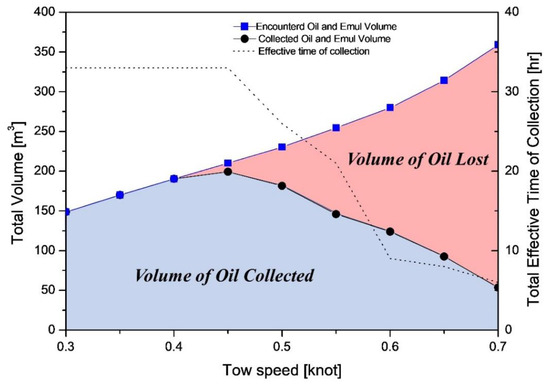
Figure 18.
Comparison of the total volume of oil collected and effective time of collection using the variable loss rate model with a constant tow speed (calculation result by case 2 in Table 2).
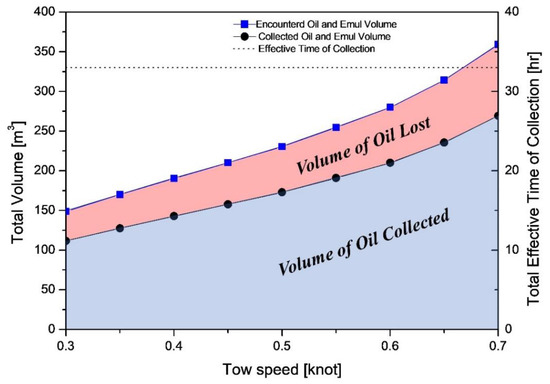
Figure 19.
Comparison of the total volume of oil collected and effective time of collection using a constant loss rate model with a constant tow speed (calculation result by case 2 in Table 2).
The variable loss rate model represents an improvement in that the response operator can estimate what tow speed is best for a given scenario, and can estimate how much oil will be lost. Although there was no significant difference in the volume of oil collected at low UTow, the constant loss rate model may have overestimated the recovery potential at high UTow values. In the case of the variable loss rate model developed in this study, the UTow of the recovery system was not arbitrarily applied by the user. The appropriate range of UTow can, instead, be determined by considering the oil loss. Therefore, it can more reliably estimate the recovery potential and effective collecting time, and can be used to determine an appropriate UTow based on TE.
5. Conclusions
To make a reliable decision on the response strategy for a given oil spill, it is necessary to know how the recovery potential is affected by various factors that may influence marine oil spill accidents. This knowledge could then be used to propose rational response equipment and determine its operating conditions. This study, therefore, focused on improving the estimation of the recovery potential. Furthermore, the effectiveness of the boom to contain the oil is strongly affected by environmental conditions such as currents, wave, and wind, and the oil property changes due to the spreading and weathering process. These factors may lead to loss of oil in the boom and a reduction of the recovery capacity of the mechanical recovery system.
In this study, two models were developed to estimate the recovery potential by considering the loss of oil from the boom. A constant loss rate model and a variable loss rate model were used. The former is the extension of the previous studies [16,17,19], and the latter is the improved model of this study. Both models considered the equipment specifications, oil behavior, and environmental conditions by calculating the spreading, weathering, and mechanical recovery every hour.
The case study was carried out to calculate how the recovery potential may vary in response to adjustments in the variables, and to study the differences between the two models. The conclusions of this study are as follows.
To overcome the limitation of the constant loss rate model, the modification of the throughput efficiency, TE, was made in the variable loss rate model. The revised TE was calculated by considering both the oil loss speed and the oil loss volume. To quantify the throughput efficiency, the empirical correlation was devised between the loss speed and volume in the variable loss rate model, deriving the first loss speed, critical loss speed, and loss rate. The relationship between the tow speed and the loss speed in the calculation procedure can be treated as a threshold for the occurrence of oil loss. The potential of collecting oil into a boom can then be estimated. In conclusion, the developed model was able to estimate not only when oil loss may occur, but also how much oil can be lost.
The low effectiveness of the recovery system due to the environmental conditions was analyzed. It is possible to find out which factors are dominant to enhance the potential for each particular environmental case. The best tow speed and specifications for the boom, which together yield the maximum potential, can be derived for different periods and environmental conditions using the developed variable loss rate model. The case study results showed that the collected oil volume could be increased in severe conditions by adjusting the tow speed. In addition, enlarging the size of the draft meant that more oil could be recovered in severe conditions. The results of the variable loss rate model developed in this study could contribute to predicting whether enlarging the boom size or controlling the tow speed is better for a given set of environmental conditions.
Author Contributions
Conceptualization, C.H. Methodology, H.K., Y.C., and C.H. Investigation and analysis, H.K., Y.C., and C.H. Writing—review and editing, H.K. and C.H.
Funding
This research was a part of the project titled ‘Marine Oil Spill Risk Assessment and Development of Response Support System through Big Data Analysis’, funded by the Korea Coast Guard, grant number KCG-01-2017-05 and ‘Development of mathematical modeling technology for CO2-CH4 multi-fluid subsea transport’, funded by the National Research Foundation of Korea (NRF), grant number 2017R1E1A1A03070672.
Conflicts of Interest
The authors declare no conflict of interest.
References
- Smith, L.C.; Smith, M.; Ashcroft, P. Analysis of environmental and economic damages from British Petroleum’s Deepwater Horizon oil spill. Albany Law Rev. 2011, 74, 563–585. [Google Scholar] [CrossRef][Green Version]
- Carmo, J.S.; Pinho, J.L.; Vieira, J. Oil spills in coastal zones: Environmental impacts and practical mitigating solutions. In IMAM—Maritime Transportation and Exploitation of Ocean and Coastal Resources; BALKEMA: Amsterdam, The Netherlands, 2005; Volume 2, pp. 1689–1696. [Google Scholar]
- Castro, A.; Iglesias, G.; Carballo, R.; Fraguela, J.A. Floating boom performance under waves and currents. J. Hazard. Mater. 2010, 174, 226–235. [Google Scholar] [CrossRef] [PubMed]
- Nordvik, A.B. The technology windows-of-opportunity for marine oil spill response as related to oil weathering and operations. Spill Sci. Technol. Bull. 1995, 2, 17–46. [Google Scholar] [CrossRef]
- Ventikos, N. A high-level synthesis of oil spill response equipment and countermeasures. J. Hazard. Mater. 2004, 107, 51–58. [Google Scholar] [CrossRef] [PubMed]
- Gregory, C.L.; Allen, A.A.; Dale, D.H. Assessment of potential oil spill recovery capabilities. Int. Oil Spill Conf. Proc. 1999, 1999, 527–534. [Google Scholar] [CrossRef]
- Pinho, J.; do Carmo, J.A.; Vieira, J. Mathematical modelling of oil spills in the Atlantic Iberian coastal waters. WIT Trans. Ecol. Environ. 2004, 68, 11. [Google Scholar]
- Fingas, M.; Brown, C.E. A review of oil spill remote sensing. Sensors 2018, 18, 91. [Google Scholar] [CrossRef]
- ExxonMobil Oil Spill Response Field Manual 2014. Available online: https://corporate.exxonmobil.com/-/media/Global/Files/risk-management-and-safety/Oil-Spill-Response-Field-Manual_2014.pdf (accessed on 13 December 2019).
- Aukett, L. The Use of Geographical Information System (GIS) in Oil Spill Preparedness and Response; Society of Petroleum Engineers: Perth, Australia, 2012. [Google Scholar]
- Fingas, M. Oil Spill Science and Technology, 1st ed.; Gulf Professional Publishing: Houston, TX, USA, 2010; ISBN 978-1-85617-943-0. [Google Scholar]
- Fingas, M. Oil Spill Science and Technology, 2nd ed.; Gulf Professional Publishing: Houston, TX, USA, 2016; ISBN 978-0-12-809413-6. [Google Scholar]
- Spaulding, M.L. State of the art review and future directions in oil spill modeling. Mar. Pollut. Bull. 2017, 115, 7–19. [Google Scholar] [CrossRef]
- ASTM. ASTM F1780-18 Standard Guide for Estimating Oil Spill Recovery System Effectiveness; ASTM International: West Conshohocken, PA, USA, 2018. [Google Scholar]
- Allen, A.; Dale, D.; Galt, J.; Murphy, J. Effective Daily Recovery Capacity (EDRC) Project Final Report; Genwest Systems, Inc.: Edmonds, WA, USA, 2012; Available online: https://www.genwest.com/wp-content/uploads/2017/04/Genwest_EDRC-Project_Final_Report.pdf (accessed on 13 December 2019).
- Dale, D. Response Options Calculator (ROC) Users Guide; Genwest Systems, Inc.: Edmonds, WA, USA, 2011. [Google Scholar]
- BSEE ERSP Calculator User Manual 2015; Genwest Systems, Inc.: Edmonds, WA, USA, 2015.
- CFR Appendix B to Part 155-Determining and Evaluating Required Response Resources for Vessel Response Plans. Available online: https://www.law.cornell.edu/cfr/text/33/appendix-B_to_part_155 (accessed on 24 September 2019).
- Dale, D. Response Option Calculator (ROC) Technical Documentation; Genwest Systems, Inc.: Edmonds, WA, USA, 2011. [Google Scholar]
- ITOPF. Use of Booms in Oil Pollution Response (Technical Information Paper No. 3). 2011. Available online: https://www.itopf.org/knowledge-resources/documents-guides/document/tip-03-use-of-booms-in-oil-pollution-response/ (accessed on 13 December 2019).
- Schulze, R. Oil Spill Response Performance Review of Booms; ASTM International: West Conshohocken, PA, USA, 1988. [Google Scholar]
- Berry, A.; Dabrowski, T.; Lyons, K. The oil spill model OILTRANS and its application to the Celtic Sea. Mar. Pollut. Bull. 2012, 64, 2489–2501. [Google Scholar] [CrossRef]
- Fay, J.A. Physical Processes in the Spread of Oil on a Water Surface; American Petroleum Institute: New York, NY, USA, 1971; Volume 1971, pp. 463–467. [Google Scholar]
- Galt, J.A.; Overstreet, R. Development of Spreading Algorithms for the ROC; Response Options Calculator: Edmonds, WA, USA, 2009. [Google Scholar]
- Lehr, W.; Jones, R.; Evans, M.; Simecek-Beatty, D.; Overstreet, R. Revisions of the ADIOS oil spill model. Environ. Model. Softw. 2002, 17, 189–197. [Google Scholar] [CrossRef]
- ASTM. ASTM F631–15-Standard Guide for Collecting Skimmer Performance Data in Controlled Environments; American Society for Testing and Materials West Conshohocken: West Conshohocken, PA, USA, 2015. [Google Scholar]
- Fay, J.A. The spread of oil slicks on a calm sea. In Oil on the Sea; Springer: Berlin/Heidelberg, Germany, 1969; pp. 53–63. [Google Scholar]
- Mackay, D.; Matsugu, R.S. Evaporation rates of liquid hydrocarbon spills on land and water. Can. J. Chem. Eng. 1973, 51, 434–439. [Google Scholar] [CrossRef]
- Delvigne, G.A.L.; Sweeney, C. Natural dispersion of oil. Oil Chem. Pollut. 1988, 4, 281–310. [Google Scholar] [CrossRef]
- Eley, D.; Hey, M.; Symonds, J. Emulsions of water in asphaltene-containing oils 1. Droplet size distribution and emulsification rates. Colloids Surf. 1988, 32, 87–101. [Google Scholar] [CrossRef]
- ASTM. ASTM F2084 Standard Guide for Collecting Containment Boom Performance Data in Controlled Environments; American Society for Testing and Materials West Conshohocken: West Conshohocken, PA, USA, 2012. [Google Scholar]
- Amini, A.; Schleiss, A. Contractile Floating Barriers for Confinement and Recuperation of Oil Slicks; EPFL-LCH: Lausanne, Swiss, 2007. [Google Scholar]
- ASTM. ASTM F2683-11(2017) Standard Guide for Selection of Booms for Oil-Spill Response; ASTM International: West Conshohocken, PA, USA, 2017. [Google Scholar]
- ASTM. ASTM F625/F625M-94(2017) Standard Practice for Classifying Water Bodies for Spill Control Systems; ASTM International: West Conshohocken, PA, USA, 2017. [Google Scholar]
- Brown, H.M.; Goodman, R.H.; An, C.-F.; Bittner, J. Boom failure mechanisms: Comparison of channel experiments with computer modelling results. Spill Sci. Technol. Bull. 1996, 3, 217–220. [Google Scholar] [CrossRef]
- Goodman, R.H.; Brown, H.M.; An, C.-F.; Rowe, R.D. Dynamic modelling of oil boom failure using computational fluid dynamics. Spill Sci. Technol. Bull. 1996, 3, 213–216. [Google Scholar] [CrossRef]
- Oebius, H.U. Physical properties and processes that influence the clean up of oil spills in the marine environment. Spill Sci. Technol. Bull. 1999, 5, 177–289. [Google Scholar] [CrossRef]
- Wicks, M. Fluid Dynamics of Floating Oil Containment by Mechanical Barriers in The Presence of Water Currents. In Proceedings of the International Oil Spill Conference Proceedings, Houston, TX, USA, December 1969; Volume 1969, pp. 55–106. [Google Scholar]
- Agrawal, R.K.; Hale, L.A. A New Criterion for Predicting Headwave Instability of an Oil Slick Retained by a Barrier. In Proceedings of the Offshore Technology Conference, Houston, TX, USA, 6–8 May 1974. [Google Scholar]
- Leibovich, S. Oil slick instability and the entrainment failure of oil containment booms. J. Fluids Eng. 1976, 98, 98–103. [Google Scholar] [CrossRef]
- Milgram, J.S.; Van Houten, R.S. Mechanics of a Restrained Layer of Floating Oil above a Water Current. J. Hydronautics 1978, 12, 93–108. [Google Scholar] [CrossRef]
- Lee, C.M.; Kang, K.H. Prediction of oil boom performance in currents and waves. Spill Sci. Technol. Bull. 1997, 4, 257–266. [Google Scholar] [CrossRef]
- Amini, A.; Schleiss, A.J. Behavior of rigid and flexible oil barriers in the presence of waves. Appl. Ocean Res. 2009, 31, 186–196. [Google Scholar] [CrossRef]
- Potter, S. The Effect of Buoyancy-to-weight Ratio in Oil Spill Containment Boom Performance; S.L. Ross Environmental Research Limited: Ottawa, ON, Canada, 2003. [Google Scholar]
- Amini, A.; Bollaert, E.; Boillat, J.-L.; Schleiss, A.J. Dynamics of low-viscosity oils retained by rigid and flexible barriers. Ocean Eng. 2008, 35, 1479–1491. [Google Scholar] [CrossRef]
- Fannelop, T.K. Loss rates and operational limits for booms used as oil barriers. Appl. Ocean Res. 1983, 5, 80–92. [Google Scholar] [CrossRef]
- Lindenmuth, W.T.; Miller, E.R.J.; Hsu, C.C. Studies of Oil Retention Boom Hydrodynamics; Hydronautics, Inc.: Laurel, MD, USA, 1970. [Google Scholar]
- Potter, S. World Catalog of Oil Spill Response Products; S.L. Ross Environmental Research Limited: Ottawa, ON, Canada, 2004. [Google Scholar]
- Korea Hydrographic and Oceanographic Agency Oceanographic Observation Portal. Available online: http://www.khoa.go.kr/kcom/cnt/selectContentsPage.do?cntId=31000000 (accessed on 24 September 2019).
© 2019 by the authors. Licensee MDPI, Basel, Switzerland. This article is an open access article distributed under the terms and conditions of the Creative Commons Attribution (CC BY) license (http://creativecommons.org/licenses/by/4.0/).
